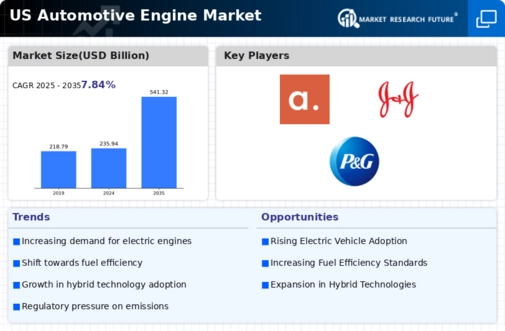Growth of the Aftermarket Sector
The aftermarket sector within the automotive engine market is experiencing robust growth, driven by an increasing number of vehicles on the road and a rising consumer inclination towards vehicle customization. As vehicle ownership rates continue to climb, the demand for aftermarket parts and performance enhancements is expected to rise correspondingly. Recent estimates suggest that the aftermarket segment could account for nearly 30% of the total automotive engine market by 2026. This growth is fueled by consumers seeking to personalize their vehicles, improve performance, or extend the lifespan of their engines. Consequently, manufacturers and suppliers are focusing on developing a diverse range of aftermarket products, including performance chips, exhaust systems, and engine remapping services. The automotive engine market is thus adapting to this trend, creating opportunities for innovation and competition within the aftermarket space.
Rising Demand for Performance Engines
The automotive engine market experiences a notable surge in demand for high-performance engines, driven by consumer preferences for enhanced driving experiences. This trend is particularly evident in the sports and luxury vehicle segments, where performance metrics such as horsepower and torque are paramount. According to recent data, the performance engine segment is projected to grow at a CAGR of approximately 6% through 2027. This growth is indicative of a broader shift in consumer expectations, as buyers increasingly seek vehicles that offer not only efficiency but also exhilarating performance. Consequently, manufacturers are investing heavily in research and development to innovate and refine engine technologies, ensuring that they meet the evolving demands of the market. The automotive engine market is thus poised for significant transformation as it adapts to these performance-oriented consumer trends.
Shift Towards Sustainable Fuel Alternatives
The automotive engine market is witnessing a notable shift towards sustainable fuel alternatives, driven by increasing consumer awareness and government incentives promoting cleaner energy sources. Biofuels, hydrogen, and electricity are gaining traction as viable alternatives to traditional fossil fuels, prompting manufacturers to explore new engine designs that can accommodate these fuels. Recent data indicates that the market for alternative fuel vehicles is projected to grow at a CAGR of approximately 8% through 2028. This transition not only aligns with global sustainability goals but also reflects changing consumer preferences for environmentally friendly options. As the automotive engine market embraces this shift, it faces the challenge of developing engines that can efficiently utilize these alternative fuels while maintaining performance and reliability.
Technological Advancements in Engine Design
Technological advancements play a pivotal role in shaping the automotive engine market, as innovations in engine design and materials enhance performance and efficiency. The integration of advanced manufacturing techniques, such as 3D printing and lightweight materials, allows for the production of engines that are not only more powerful but also lighter and more fuel-efficient. For instance, the adoption of variable valve timing and direct fuel injection technologies has been shown to improve fuel economy by up to 15%. As these technologies become more prevalent, the automotive engine market is likely to witness a shift towards engines that offer superior performance while adhering to stricter fuel efficiency standards. This ongoing evolution in engine design reflects the industry's commitment to meeting consumer demands for both power and sustainability.
Regulatory Compliance and Emission Standards
The automotive engine market is significantly influenced by stringent regulatory compliance and evolving emission standards imposed by government agencies. In the US, the Environmental Protection Agency (EPA) has established rigorous guidelines aimed at reducing greenhouse gas emissions from vehicles. As a result, manufacturers are compelled to invest in cleaner engine technologies, such as turbocharging and hybrid systems, to meet these standards. The market for low-emission engines is expected to expand, with projections indicating a growth rate of around 5% annually through 2026. This regulatory landscape not only drives innovation but also shapes consumer preferences, as buyers increasingly favor vehicles that align with environmental sustainability. The automotive engine market must navigate these complex regulations while striving to maintain performance and efficiency, creating a challenging yet dynamic environment for manufacturers.














Leave a Comment